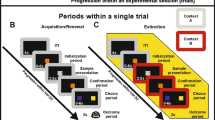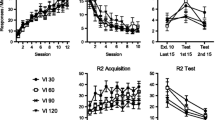Abstract
Albino rats were repeatedly conditioned and extinguished on a bar-pressing response in three experiments that employed number of reinforcements, and either pattern of reinforcement or schedule of reinforcement as the independent variables. The extinction functions obtained were interpreted as evidence that (a) number of reinforcements is not an unequivocal determinant of extinction responding, and (b) further investigation of the relative contributions of both the reinforcement and non-reinforcement histories of the organism to subsequent extinction responding is needed, if the extinction functions obtained from alternating aquisition-extinction paradigms are to be accurately predicted.
Similar content being viewed by others
References
BULLOCK, D. H., & SMITH, W. C. 1953. An effect of repeated conditioning-extinction upon operant strength. Journal of Experimental Psychology, 46, 349–352.
BUSH, R. R., & MOSTELLER, F. 1951. A mathematical model for simple learning. Psychological Review, 58, 313–323.
CLARK, R. C., & TAYLOR, B. W. 1960. Effects of repeated extinction of an operant on characteristics of extinction curves. Psychological Reports, 6, 226.
DENNY, M. R. 1959. One bar-press per day: Acquisition and extinction. Journal of the Experimental Analysis of Behavior, 2, 81–85.
GUTHRIE, E. R. 1952. The psychology of learning. New York: Harper.
HARRIS, P., & NYGAARD, J. E. 1961. Resistance to extinction and number of reinforcements. Psychological Reports, 8, 233–234.
HAYS, W. L. 1963. Statistics for psychologists. New York: Holt, Rinehart and Winston.
HEARST, E. 1961. Resistance to extinction functions in the single organism. Journal of the Experimental Analysis of Behavior, 4, 133–144.
HILL, W. F., & SPEAR, N. E. 1963. Extinction in a runway as a function of acquisition level and reinforcement percentage. Journal of Experimental Psychology, 65, 495–500.
HULL, C. L. 1943. Principles of behavior. New York: Appleton-Century-Crofts.
HULL, C. L. 1952. A behavior system. New Haven: Yale University Press.
ISON, J. R. 1962. Experimental extinction as a function of number of reinforcements. Journal of Experimental Psychology, 64, 314–317.
ISON, J. R., & BIRCH, D. 1961. T maze reversal following differential endbox placement. Journal of Experimental Psychology, 62, 200–202.
JENKINS, W. O., & STANLEY, J. C, Jr. 1950. Partial reinforcement: A review and critique. Psychological Bulletin, 47, 193–234.
LAUER, D. W., & ESTES, W. K. 1955. Successive acquisitions and extinctions of a jumping habit in relation to schedule of reinforcement. Journal of Comparative and Physiological Psychology, 48, 8–13.
MOWRER, O. H., & JONES, H. M. 1945. Habit strength as a function of the pattern of reinforcement. Journal of Experimental Psychology, 35, 293–311.
NORTH, A. M., & STIMMEL, D. T. 1960. Extinction of an instrumental response following a large number of reinforcements. Psychological Reports, 6, 227–234.
PERIN, C. T. 1942. Behavior potentiality as a joint function of the amount of taining and degree of hunger at the time of extinction. Journal of Experimental Psychology, 30, 93–113.
PERKINS, C. C, Jr., & CACIOPPO, A. J. 1950. The effect of intermittent reinforcement on the change in extinction rates following successive re-conditionings. Journal of Experimental Psychology, 40, 794–801.
SCHAEFFER, R. W. 1963. N-Reinforcements and extinction responding. Psychological Record, 13, 347–354.
SCHAEFFER, R. W., SALZBERG, C. L. BIRKLE, R. A., & RYAN, F. J. 1967. Resistance to extinction as a function of reinforcement patterns. Psychological Record, 17, 353–358.
SKINNER, B. F. 1938. Behavior of organisms: An experimental analysis. New York: Appleton-Century-Crofts.
SKINNER, B. F. 1950. Are theories of learning necessary? Psychological Review, 57, 193–216.
SKINNER, B. F. 1956. A case history in scientific method. American Psychologist, 11, 221–233.
WICKENS, P. D., & MILES, R. C. 1954. Extinction changes during a series of reinforcement-extinction sessions. Journal of Comparative and Physiological Psychology, 47, 315–317.
WILCOXON, F. & WILCOX, R. A. 1964. Some rapid approximate statistical procedures. Pearl River, New York: Lederle Laboratories.
WILLIAMS, S. B. 1938. Resistance to extinction as a function of number of reinforcements. Journal of Experimental Psychology, 23, 506–521.
WINER, B. J. 1962. Statistical principles in experimental design. New York: McGraw-Hill.
YOUTZ, R. E. P. 1938. Reinforcement, extinction, and spontaneous recovery in a non-Pavlovian reaction. Journal of Experimental Psychology, 22, 305–310.
Author information
Authors and Affiliations
Additional information
This research was supported in part by Public Health Service Research Grants MH-08775, MH-08795, and MH-12025, Robert W. Schaeffer, principal investigator. Our indebtedness to R. E. Lushene, T. A. Smith, and R. B. Shumake for their assistance in carrying out the statistical analyses reported in this paper is gratefully acknowledged.
Rights and permissions
About this article
Cite this article
Schaeffer, R.W., Burks, C.D., Ternes, J.W. et al. Resistance to Extinction Functions in Rats Exposed to Alternating Acquisition and Extinction Sessions. Psychol Rec 19, 225–245 (1969). https://doi.org/10.1007/BF03393846
Published:
Issue Date:
DOI: https://doi.org/10.1007/BF03393846




